In a Yahoo Group for Quilt Teachers, there is an interesting discussion going on about fabric requirements for quilt patterns.
Some designers add 10%, or add enough for one miscut strip, or round up to the next quarter yard. Some designers don’t add anything for mistakes or shrinkage. There is no industry standard.
I would like to know what you think—as a quilter, a designer, or a teacher.
AS A SEAMSTRESS
My mother let us sew on the sewing machine before we were old enough to go to kindergarten. In public school, I made some of my own clothes, and in high school, I made almost everything. Mum taught me that the fabric requirements on patterns were too generous because they had to allow for tall people—and I am the runt of the litter.
It became a routine to shorten hems and sleeves on the tissue paper, lay the pieces out on the dining room table, and measure to determine how much I really needed. Mum was right of course. If it said I needed 1.875 yards, I might only need 1.5 yards.
There was no joy in having scraps left over, the way there can be for quilters. If I bought 1.875 and only used 1.5, I was wasting my hard-earned babysitting money.
I also learned that if there was fabric in the closet that Mum would let me use, even though the pattern said I needed more, I could sometimes make it work.
AS A QUILTER
I often work from my stash. If a pattern indicates a half yard of a fabric, it is difficult (if not impossible) to tell if the smaller piece in my stash will do. If I substitute something else, I am disappointed if I discover later that I could have used my first choice.
We all know that fabric manufacturers are in a wicked, wicked conspiracy to ship new fabric lines so often, and in such small runs, that we will never find more later. They are training us. LOL “If you like it, you must buy all of it now because you may never have another chance. It’s now or never.”
My preference as a quilter is to see a layout, even a simplified one, so I can be a smart consumer. Of course, I also want to see the fabric requirements listed, but for me, a diagram improves the pattern and empowers me.
If a pattern designer is going to routinely add enough for cutting errors, as a quilter, I hope she would make a note of it on the outside of the package with the other fabric requirements. For example:
- “Fabric requirements are generous in order to allow for cutting errors. You may need less.”
- “There are cutting diagrams to help you determine how much fabric you should buy if you prefer to allow for errors.”
- “A yard of fabric usually measures less than 36 inches after washing. These fabric requirements assume average shrinkage of x%.”
AS A DESIGNER
Since I learned to work from the layouts in clothing patterns, I feel comfortable with diagrams, so when I designed the Inklingo Snack Quilt Pattern, I included images like the ones above. They clearly indicate the shape, the fabric key, the width of the fabric, efficient custom page sizes for printing, etc. At a glance, a quilter can see what she needs, and make better decisions.
Designers should know that some quilters assume that the pattern lists the minimum requirements, so they automatically buy extra. If there is already extra in the fabric requirements, that can add up to a lot of Extra!
ARE YOU A PATTERN DESIGNER?
If I have convinced you that a diagram for the cutting layout will add value to your pattern, that is another reason to love designing with Inklingo.
In every Inklingo Shape Collection, there are Suggested Custom Page sizes for efficient use of the fabric, diagrams, and tips for calculating fabric requirements. You can see them in the free shape collection for Diamonds, Triangles, and Squares.
Inklingo quilters want more and more Inklingoable patterns and classes. We want all quilt designers to include Inklingo info in their patterns, so I am doing everything I can to make it easy and profitable. In fact, thanks to the Inklingo Affiliate Program, pattern designers can make more when they recommend an Inklingo Shape Collection than when they recommend traditional tools!
Designers can also unleash their creativity by designing and selling patterns that are easy with Inklingo but would be too difficult or expensive with traditional tools. Inklingo makes Double Wedding Ring, Alabama Beauty, Pickle Dish, Winding Ways, Clamshell Pickle, Fancy Dresden Plates, and other designs possible for more quilters.
You can design patterns for Inklingo.
You don’t need my permission, but if you contact me, I can help with graphics and other support. If you need logos, images, info about efficient custom page sizes, fabric requirements, Monkey’s Cheat Sheet—whatever—I can probably give you anything you need. There is no fee. I am even willing to design custom shape collections, if appropriate. Appliqué designs are ideal for custom collections.
Inklingo provides unique resources to designers, like Monkey’s Cheat Sheet. It is a great way to stay organized, whether you are a designer or a quilter.
If you haven’t tried Inklingo yet, please order and download the free shape collection now, and see what you’re missing!
WHAT DO YOU THINK?
I think you can see that as a quilter, I have strong opinions about how designers can improve the way they describe fabric requirements, either by clearly explaining their own approach or by adding diagrams. Inklingo allows everyone to put it into practice.
- As a quilter, do you expect designers to include extra fabric in case you make a mistake? How much more?
- As a quilter, do you buy more than the amount listed in the pattern, in case you make a booboo?
- As a quilter, do you buy exactly what the pattern recommends, or do you work from your stash?
- As a teacher, what do you tell your students?
- As a designer, what do you do? Why? Is it explained in the pattern?
- As a designer, do you add extra for shrinkage?
Please let me know your experiences (good and bad) with fabric requirements. If you prefer to write privately, that is fine too. I am interested in what you think.
By the way, I got nostalgic looking at my old patterns. Fond memories below.
Thank you for visiting. Please leave a comment.
Linda & Monkey
This is the “Good Old Days” bonus material:
1. I have only saved a few of my early patterns. The ones I saved cost 50 to 65 cents. As a babysitter, I earned 50 cents an hour.
2. I was 15 when I bought my first Vogue pattern. It was a memorable splurge at $3.30 CDN, but it included the fabulous cloth label. I loved that dress and wore it for years. When I threw it away, I saved the label.
3. Visiting Aunt Lucy in sundresses made by Mum. (I’m the short one on the left wearing hand-me-downs.) I am glad I don’t have photos of me in my first creations. I’m sure they are better in my memory than they were in reality. Our family has a dominant photo gene. Everyone loved taking photos and making photo albums (called scrapbooking today). My Dad even had his own darkroom. We have lots and lots of photos, but none of me in the beloved sailor dress or the Vogue creation. I’m glad I got the photo gene and therefore can be behind the camera most of the time now.

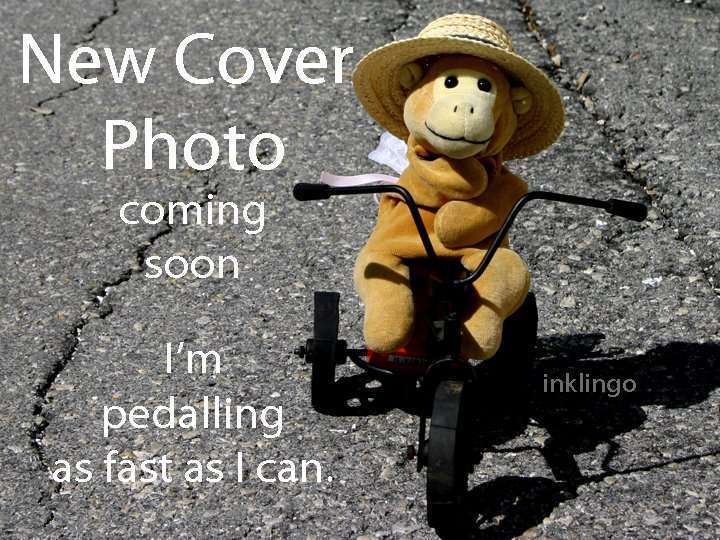
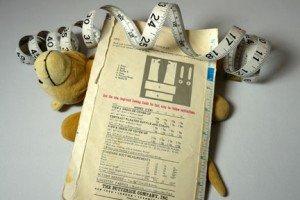
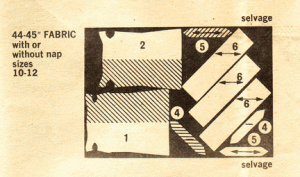


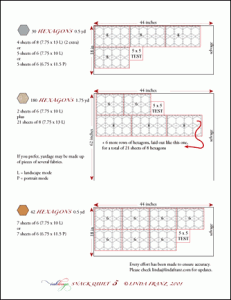
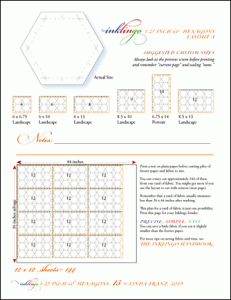
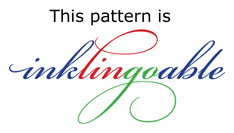
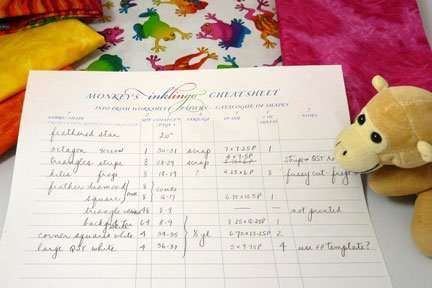

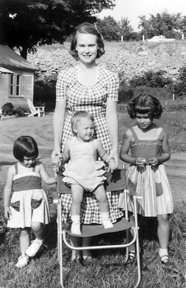
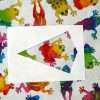
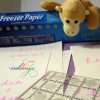
Hello from the bottom of the world.
In New Zealand we mostly do our patchwork in inches as most books and rulers are in imperial measurements, however when we buy our fabric we convert it to metric (even our Fat quarters are 50 cm long) most shops will cut to the nearest 10 cm ( 4 inches) .
Therefore if a pattern’s fabric requirements have already been rounded up to the next imperial measurement we would then be rounding it up again even further.
I would prefer to know what the minimum fabric requirements are and then use my discretion.
Patchwork fabric here costs about $ 32 meter so we tend to be a bit stingy anyway ( I too come from a dressmaking background and stinginess is ingrained!)
I also like to use up my stash. ( I didn’t accumulate it just to stroke!)
(“Scraps” here are smaller too . I think it is directly related to the cost of the fabric)
Any way I’m going back out into the sunshine (summer is nearly over)
We have a similar situation in Canada, Claire. I agree with you!
What a trip down memory lane! Your early sewing experience closely mirrors my own. I no longer have any of the clothing I made either but I sure do have memories. My favorite is winning a ribbon (and prize money!) in the adult division at the fair when I was 8. I’d made myself pink baby doll pajamas and my mother entered them in the adult division because the prize money was a few dollars vs. a quarter or so in the junior division.
I’m totally obsessed with making the best use of fabric – even if I have LOTS. It just doesn’t matter – I can’t stand to waste any. After reading your story, I think it relates back to clothing sewing for me, as well. You’re right – seeing the layout is invaluable and I will incorporate that as appropriate in my future patterns.
As for cutting requirements, I usually round up to the nearest quarter or third yard. Where I have to be careful is in forgetting that not everyone shares my fabric-conserving neurosis. So I try to calculate yardage based on what a regular person would do rather than someone who feels compelled to find the best use for every last inch:)
Hi Peggy,
I agree that it is very upsetting to run out of fabric. Definitely better too much than not enough. Everyone agrees on that. We are on the same track.
The important thing is to make it clear to the quilter. Either way is fine.
If the minimum amount is listed, the quilter needs to know.
If the designer adds extra for “just in case,” the quilter needs to know that too.
I have had a lot of private mail about this today. As one quilter said, “You can’t say I made the decision to make you to buy extra without telling you, because you can always add it to your stash, and then act like I never want to use my stash. You can’t have it both ways.”
She has been disappointed. Clear enough.
The responses indicate that pattern-buying quilters like to use their stash, at least some of the time. I think quilt patterns designers who help them do that will make their customers happy. In many cases, a simple statement about your approach will do. Adding a cutting layout (when possible) will lift you above the competition.
I think Anneke’s comment explains the attitude of many quilters. Thank you for adding your thoughts to the conversation!
Hi Ruth,
I agree. I did not imagine that the cutting diagram would be on the cover. I don’t think that would be necessary or appropriate. All you would need to put on the cover is something like this below the fabric requirements:
“The fabric requirements allow a little extra for shrinkage (and maybe a cutting mistake!), and I recommend you buy at least that much, but this pattern is also Stash Friendly! The cutting diagrams will help you determine whether pieces in your stash are large enough.”
I’m not completely happy with that wording, but I’ve been answering a flood of responses on this topic all day, and my brain is beginning to fry. That wording should do as a starting point for it.
The cutting diagrams don’t need to be on the cover. The quilter is going to take it home and play with her stash to see if she has enough, and she knows you have treated her with consideration. She has a good feeling about it.
I have no problem at all with designers who want to provide generous fabric estimates, but I think it is wrong if they don’t tell me that is what they do.
Either way works, as long as the purchaser is given the right info–either you specify a minimum, or you specify that you recommend more, but that you are considerate enough to provide diagrams or more detail so the quilter has the info she needs to use her stash.
It really shouldn’t be complicated. It’s just a variation of Golden Rule. Treat others the way you would like to be treated, and they will love your patterns and be back for more!
This topic has touched a chord, and it is clear that successful quilt designers are always looking for ways to make their patterns better and better, and make them stand out from the rest. Thank you very much for adding to the conversation!
Hi Linda,
I am so glad I decided to look at you blog and comments about Fabric Calculations. I am also following it in the Quilt Teach yahoo group.
I came from a clothing backgound and learned quickly the types of garments I needed extra fabric and the type I could use less fabric by looking at the layouts.
When I design quilt patterns I base my figures on 40″ WOF. I agree with cutting larger pieces first and try to cut some smaller pieces from any leftovers. I have never used a cutting layout in my patterns, but that is a good idea. I have seen others use layout charts when I have tested for others. I have put in the pattern to cut a strip the size of the largest piece and also cut smaller pieces after cutting the large size pieces.
Now I do add a bit of fabric to each fabric amount needed, but never larger then the largest piece needed unless it is to round up to the next 1/8th of a yard. I do this because I rarely cut and entire quilt with out making a minor cutting mistake. Usually I mis-cut when I cut lots of strips the same size. My mind will be thinking about the sewing while I should be thinking about the cutting.
The discussion on Quilt Teach started when someone was teaching a commercial pattern designed by someone other then the teacher. The teacher noticed too much fabric was required. Should the teacher put less fabric on the requirements for the class? I say no. I think if there was not enough of a fabric I would say something. Too much fabric is a safety measure, if it is not excessively extra for each fabric. A combined amount of all the required fabric should not be consided extra fabric amount. I think excessive amounts of fabric is a reflection on the designer of the pattern, not the teacher unless they are one in the same.
As a former Quilt Shop owner, back when there were less designers, I never had anyone complain about the amount of fabric required. Recently I worked in a quilt shop for a few months before it closed and heard more complaints about instructions being wrong or not enough fabric listed. I never heard anyone complain about too much fabric required.
I also remembered when I was a new quilter I was always jealous of those with a stash who could make scrap quilts. I was stuck for years making two and three fabric quilts that were so popular at the time.
Dear Linda,
This is a very enlightening post! I have never made a quilt from a pattern, and never bought a pattern, and I had no idea yardage estimates could be so off. I completely agree with you.
Before reading this post I would certainly have expected some statement of how yardage was estimated, and some notes for unexperienced quilters about shrinkage, fabric width etc. If it was not there, I would not even consider buying the pattern. I would have no faith at all in the designer!
I want to know the absolute minimum of fabric required, because I too work from my stash, and want to know exactly which pieces are suitable. When I buy fabric, I want to decide for myself whether I will take the chance of not having enough fabric in the end, or buy extra to add leftovers to my stash. I would not mind being forced to be extra creative if I ran out of fabric!
I actually think it is patronizing from a designer to tell me to buy too much, without telling me there is extra in case I should make a mistake. To me that would almost feels like they are spending my money! And I do not like that at all.
I love how Inklingo empowers us with fabric layout diagrams for custom sizes! It is very helpful and the work you have put into each collection saves us all so much time (and money).
Thank you once more!
Linda, you make a lot of valid points. I’m also a designer and always interested to hear how to improve my patterns so my customers are happy. There are a lot of good points mentioned above and I like the idea of adding a cutting diagram, but have a question. I often have limited space on the pattern cover to include a cutting diagram so where would one put this? I have several thoughts, but they are not always appropriate. Inside the pattern means it would need to be removed to see it. On the website means its not always accessible when making the fabric purchase. A copy to the store owner might work, but then that’s more paper work/storage for them. So where would you suggest to put such a chart if you don’t have enough room on the cover?
I think there are lots of reasonings why designers do what they do. Trying to keep quilters, shop owners, teachers, kit makers and fabric manufacturers happy is not an easy task, and basically it all falls back on the shoulders of the designers, no matter which avenue we take. We can only do our best and not everyone will always be happy. Thanks for the help.
Linda, once again you step up as a thoughtful and respected member of our community. I appreciate your tools and patterns, but I appreciate your exploration of the social, financial, practical and artistic aspects of our world just as much.
I’m a designer, too. But I’m in a slightly different boat than many designers. Most of my patterns begin as Mystery quilts which I offer on my Yahoo group. So I’ll share with you my thoughts on fabric calculations — for my particular part of the quilting world.
I generally calculate the fabric and round it up to the next 1/4 yard. If I’m only a few inches from a 1/4 yard, I’ll round up to the next half yard. So in your scenario, I’m the designer who rounds up 17″ of fabric to 3/4 yard. I’ve never liked dealing with eighths and thirds of yards. A quarter yard is only 9″ so I feel that’s a reasonable place to go. I might mention that my patterns are usually written for quilts (not other items that use less fabric) in a variety of sizes from Crib to King. If I were designing, say, tote bags or smaller items, I’d probably list the exact pieces needed.
I really like your diagram practice. And since I, too, came to quilting from garment construction, I can read a pattern diagram. I, too, always trimmed hems and such before laying out a pattern. And I’m so old that I remember laying out a garment in the fabric store! The clerks would let us take the pieces out of the package and do our figuring right on the spot!
In a mystery pattern, I don’t think a diagram would work. I think it would give away too much of the mystery.
When I “round up” on fabric requirements, I mean NO disrespect to the quilters who trust me with their time and fabric. But I’ve always pre-washed my fabric. And I don’t have to tell you about the yards of fabric I’ve lost over my lifetime of sewing to truing-up ragged, frayed or simply slanted edges of fabric. Right now I’m working on a project that uses dozens of fat quarters. The minginess of some shops is understandable, but frustrating. The fabric may have been exactly 18″ wide when it was cut, but I have a couple where I’m getting more like 14″ of usable width. When I design a FQ pattern I usually state that the quilter may want to add a couple FQs to allow for under-sized pieces.
And let’s not even talk about fabric width! I always note on my patterns that I’ve calculated the fabric based on 40″ of usable fabric. I’ve seen some fabrics where 40″ is a stretch once you cut off the selvages. I have had a couple people say they had “lots” of fabric left over on one of my projects. I think that ordinarily happens when they use a fabric that happens to be wider (like many batiks). If a pattern uses, say, lots of 2″ patches, and the quilter can get two extra patches from a WOF strip, you can see where she’ll have fabric left. Also, many of my members are experienced quilters who may use different techniques for constructing units than the ones I give. HSTs are particularly thorny here. I choose the method I think easiest for the particular project. But many members choose to use their own favorite method which may take a bit more or a bit less fabric.
My Yahoo group is quite frank with feedback. If they think there’s too much or too little fabric they will let me know! (I once had a member complain that I used too much blue print in my patterns, and it emptied her blue printer cartridge too fast; she said I should use other colors to even things out! This comment, in regard to a free pattern!)
I’m no shill for any fabric company. In fact these days I tend to design patterns that can use scraps. But I think all designers just want quilters to have a good experience with our patterns. And as several folks have said, we’ve all been bitten by the not-quite-enough beast, so we’re twice-shy of it.
I do think your suggestion of noting on our patterns our “philosophy” is a great idea. I try to explain that and I’ll think further about how I can explain clearly just what people can expect from my patterns.
I would be really pleased if the designer indicated a cutting diagram! I am a visual person and can follow pictures much easier than words. A general statement in addition to the diagram about how much extra (or not) the designer included in requirements would be a definite bonus.
Would you believe I had that very same “sunsuit” pattern shown at the top of your blog entry? I remember it (about) 1965 or so…. I looked GOOD! Of course that was about 30 pounds ago!
Thanks for the memory!
Thanks for the comment Linda.
I like to work from my stash too. I like a variety in my quilts, not just one fabric line.
Here’s my problem.
1. The pattern designer calculates the requirement at 17 inches, and decides to call it 0.75 yard, just to be safe.
2. There is no diagram of the cutting layout, and no statement on the pattern that the yardage is generous.
3. I have the perfect fabric in my stash, washed and ready to go, but I measure, and there is only 19 inches left.
4. I am disappointed.
5. If there was a diagram, I would be thrilled to see I can use my first choice.
Maybe I look for another pattern instead, which will allow me to use my preferred fabric. Maybe the designer has even lost a pattern sale.
I wish designers would clearly state how they calculate the yardage, or provide a diagram, so I can use the extra I bought last time!
Very interesting comments with a good insight from both designers and quilters. As a designer, my patterns call for a generous amount to allow for cutting errors. As a quilter using another designer’s pattern, I choose fabrics that I like and not necessarily those shown in the sample. If there is leftover fabric, I add it to my stash. I rather have more than not enough.
I probably don’t have the sewing/quilting experience that many of you have. My project in junior high school, an a-line skirt with side zipper, was thrown in the scrap pile for other students to practice on, after the teacher gave me a -C.
I now smock for my two granddaughters. I buy my fabric and have it pleated at the same store. They cut out the dress front and pleat it for me. I always I have oodles left over. I have had to ask for less fabric. My first quilting teacher taught me to calculate my own yardage. After my calculation, I decide how much more fabric I want to purchase. There are some fabrics I just don’t want more of in my stash. In my opinion, I think patterns should state CLEARLY whether fabric has been added so the consumer can make the choice. I have always wondered if pattern designers based their yardage requirements on fabric that had been pre-washed because that is normally not stated either. I usually see statements such as “recommend testing your fabric” or “recommended pre-washing” It would not be difficult for a designer to make a declaration on the pattern as to their fabric calculations and how they were based. As a consumer, I would appreciate such a notation and think the pattern designer was very considerate and thoughtful to indicate so. Fabric calculations are so much easier with Inklingo! Thank you Linda for this thought provoking post. I think it is something that all pattern designers should consider.
Hi Julie,
You and I think alike!
Here’s a tip for you. If you cut one of your letter size sheets to a custom size, like 6 x 9, to print exactly the number of shapes you need, save all of those scraps of heavy freezer paper. You can overlap the scraps to make “new” sheets of freezer paper, as big as you like. This is one of my favorite tips in the first chapter of The Inklingo Handbook, page 41 (or page H41 in the download), and that’s saying something, because there are a lot of neat tips in there!
Thank you, Beginning Quilting!
Since you work with beginners through your web site, you might want to see the notes about fabric on pages 37 and 38 of the free shape collection. The illustrations help sewers who are new to quilting (and even some of us oldies).
Hi Michelle,
Thank you for leaving your comment. You made some great points. The last line made me smile. 🙂
Hi Terry,
I think you and I share the same enthusiasm for fabric! I normally want to have a little extra, but if the designer has already added a little extra, I want to know, so I don’t end up with a lot extra.
I like to recommend exactly what the quilter needs (assuming she washes her fabric, because I recommend that), but I add a note like “Buy the best fabric you can afford, and buy extra if you can.” or “No matter how carefully you calculate the exact amount, it is a good idea to buy a little extra to allow for shrinkage and mistakes.”
Quilters are happy as long as we tell them what our fabric requirements mean, either in words or diagrams, or both.
As a quilter, I prefer that the pattern tells me to buy exactly what I will need. I usually end up with plenty of scraps without designers asking me to buy extra fabric.
As a designer, I set fabric requirements at the amount needed. I do allow for possible shrinking. For example, if the pattern would need 17″ of a particular fabric, I will say to buy 3/4 yard since it is quite likely that a half yard would shrink or be cut so that getting 17 usable inches would be impossible.
As to someone who puts fabric aside for five years and then makes an error – if that was me I would figure it was my own fault and not blame the designer. There is so much fabric out there, I’m sure I could find something to substitute for the one I made the mistake with.
As a quilter I have rarely followed a pattern to make a quilt, so I usually calculate my own yardage. I get so frustrated by reading the directions that call for 1 10″ square that recommends that you buy a 1/2 yard of material. I understand that not everyone is capable or, if they can, wants to bother with this.
As a pattern maker in a shop I am often shocked by how much extra material a pattern calls for.
Now that I have begun working with the public I see quilters from all ranges of experience. I understand why designers add so much extra to their patterns. People make a lot of mistakes. I do believe it is easier to have extra fabric in the requirements than to have people complain that there is not enough.
I agree with you about putting some kind of statement about the yardage being generous.
I have always liked the idea of a cutting diagram.
Although, personally, I do not like the extra yardage, I see the need for it. I do think that people should be aware of what they are buying and should be able to make a decision based on their own comfort level.
I think that people who can calculate yardage will and those who can’t will learn to love scrap quilts.
when i first started quilting i always bought i yard more of each fabric in case i ran out. now that i have moved on i find i want scraps instead of yardage. i love having several reds in something instead of several yards of one red. so now i buy fat quarters, which works well for me. my printer preferns the freezer paper that comes in letter size sheets, and it happens to be the widest it can print anyway. i was happy to discover that a FQ can take 4 sheets of this paper with little wastage.
i for one prefer patterns to have more yardage but i think they should say so allowing experienced quilters to make a choice f they wanted to.
Great information here! You’re great at explaining things step by step. Thanks for this post!!
I prefer to make my own choice regarding whether I’ll have extra left over. The very first pattern I ever used when I started quilting overstated the amounts of fabric required by a fairly large amount. It left me wondering if all patterns would be like that or if it was a huge guessing game.
As it turned out, after the first quilt or two I rarely ever followed a pattern anyway and learned to figure it out for myself. But I think it’s extremely important for quilters to, at the very least, be given enough information to enable them to understand what the designer’s requirements really mean — that there will be quite a bit left over, that it’s going to be very close not allowing for any errors or somewhere in between.
One of the first quilt books I read had a line that really stuck with me — something along the lines of “if the pattern calls for a yard, buy a yard and a quarter” et cetera as a good way to build up one’s stash. I do think it’s a great way to add to stash, but it would be helpful if the patterns clearly stated what the requirements really mean so that it’s the quilter’s choice to buy extra or not.
In my view, more is better…more than enough is a requirement! Lots of quilters (myself included) buy the pattern and all the fabric and put it away to do “someday”. It could be five years or more. If that quilter bought my pattern, I want her to have plenty to make that quilt without having to try to find more of the fabric she purchased “back then”. I often state that the yardage given for this project is generous to allow for shrinkage and an occasional oops! When I design for a fabric company, most prefer that I be generous with yardage, not just to sell more fabric but for the same reasons I stated above. I don’t apologize for having too much fabric…only when parts can’t be cut from yardage given. One exception was when I listed 12-16 fat quarters for an Iron Tote project. I printed hundreds of patterns with this requirement. So I made a little sticker that says “Pardon our enthusiasm; 5 or 6 fat quarters will do.”
I agree with you completely, Ronda. It is better to have too much than not enough. However, I think the designer’s approach to calculating yardage should be clearly stated on the pattern, so the quilter can make her own decision.
Adding a diagram of the cutting layout is even better. I wish all patterns did it.
Some designers seem to assume that quilters will make cutting mistakes. Maybe there would not be so many cutting errors if the directions were clearer.
A sticky situation. I’d rather have too much than not enough. And new quilters might not see the best cutting method or they might make a mistake, and then be out of the fabrics.
I am rounding up about 1/4 yard for actual yardage for my patterns, but not when I’m making a pattern that works with fat quarters. I’m currently writing up my binding tutorial, and deciding whether to cut it close on the yardage, or round it up a bit or a lot. Frankly, I love having extra yardage, and I just don’t understand that whole “use it all up” mentality.
As a scrap quilters, having yardage to make an entire this or that is not an issue for me, but many new quilters, by manufacturers’ well crafted advertising or not, seem to like their quilts made out a particular designed to all coordinate “line.” So if it’s sold out before they get to the stitching, and they make a mistake, there’s going to be unhappiness.
Did I mention that I’d rather have too much than not enough? How much was “too much” in this particular quilt class?
~ Ronda
Navy with white pleats, eh? Already you were color-scheming for Quilted Diamonds!
🙂
As far as yardage goes, I follow directions and have fun with the scraps. I assume the designers know what they are talking about. Maybe I shouldn’t after seeing all the possibilities above. Thanks for enlightening me.
By the way, in addition to the photo gene, I think you also inherited the Patent gene.